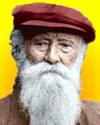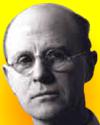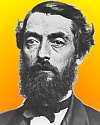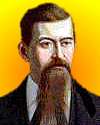
On 29 Mar 1921, John Burroughs died. As a naturalist and author, his writings were after the manner of Henry David Thoreau. You can enjoy his reflections on nature with this short sample, an excerpt from Under the Apple-Trees (1916), the chapter called “The Friendly Rocks.”
It’s a quick read, but let it sink in, and on the next on the next walk you take in the country, the simple stones and rocky outcrops you see will pleasantly remind you of Burroughs’ words.

On 29 Mar 1900, Charles S. Elton was born. He is credited with describing the “sociology and economy of animals,” thus outlining the basic principles of modern animal ecology. Elton thought of the “community” as the group of species in a habitat. Today's book pick is: , by . The devastating effects on the local ecosystems that invasive species cause are explained in this book.
Just like Rachel Carson’s Silent Spring was a call to action against the pesticides that were devastating bird populations, this classic by Elton sounded an early warning about an environmental catastrophe. He gives numerous examples, from kudzu to zebra mussels to Asian long-horned beetles. Around the world, nonnative species are colonizing and taking over habitats at an alarming rate. This leads not only to extinctions of native animals and plants, but there is financial damage costing billions of dollars.
Charles S. Elton was one of the founders of ecology, and readers of this book will find his foresight was prescient. It’s a good read.
It is available from Amazon, typically about (As of earlier time of writing - subject to change.)
 | Life became a science when interest shifted from the dissection of dead bodies to the study of action in living beings and the nature of the environment they live in. |
 | The floating vapour is just as true an illustration of the law of gravity as the falling avalanche. |
 | Food is the burning question in animal society, and the whole structure and activities of the community are dependent upon questions of food-supply. |
| Before you look at today's web page, see if you can answer some of these questions about the events that happened on this day. Some of the names are very familiar. Others will likely stump you. Tickle your curiosity with these questions, then check your answers on today's web page. | |
| Births | |
 | Charles Elton, born 29 Mar 1900, was a English biologist. In 1927, he described the way plants get energy from sunlight, plant-eating animals get their energy from eating plants, and meat-eating animals get their energy from eating other animals. Elton’s pyramid of numbers shows how energy flow links those successive tiers of organisms to form the biological community. By what name is this sequence of energy transfers known? |
 | Edwin Drake, born on 29 Mar 1819, was an American who drilled the first productive oil well that launched the modern U.S. petroleum industry. He used an old steam engine to power the drill. On 27 Aug 1859, he struck oil at a depth of 69 feet. After his well began to produce oil, other prospectors drilled wells nearby. Other men, with better business sense, grew rich from the oil boom, yet Drake died in poverty. In which State did Drake drill to make his oil strike? |
| Deaths | |
 | An American cellular geneticist (1918-1997) conducted research (1950s-60s), with which she altered the prevailing view about where genetic material was within the cell. In particular, she recognized that a second set of genes were found outside of the cell’s nucleus. Even though they were nonchrosomomal, these genes also influenced inherited characteristics. Before her work, only the chromosomal genes had been considered to control genetic behaviour. What is the name of this scientist? |
| Events | |
 | On 29 Mar 1886, Dr. John Pemberton brewed a concoction over a backyard fire. He created it as a cure for “hangover,” stomach ache and headache. He advertised it as a “brain tonic and intellectual beverage,” and first sold it to the public a few weeks later. Pemberton’s product led to which present-day beverage? |
Fast answers for the previous newsletter for March 28: He designed a vast sewer system, serving all of London, to solve the huge problem of sewage pollution in the River Thames • Jean-Maurice-Émile Baudot • Three Mile Island nuclear power plant, outside Harrisburg, Pennsylvania • UNIVAC.
 If you enjoy this newsletter, the website, or wish to offer encouragement or ideas, please send feedback by using your mail reader Reply button.
If you enjoy this newsletter, the website, or wish to offer encouragement or ideas, please send feedback by using your mail reader Reply button. Your click on a Facebook, StumbleUpon, or other social button on the site webpages is also a welcome sign of appreciation. Thank you for using them.
© This newsletter is copyright 2020 by todayinsci.com. Please respect the Webmaster's wishes and do not put copies online of the Newsletter — or any Today in Science History webpage. (If you already have done so, please remove them. Thank you.) Offline use in education is encouraged such as a printout on a bulletin board, or projected for classroom viewing. Online, descriptive links to our pages are welcomed, as these will provide a reader with the most recent revisions, additions and/or corrections of a webpage. For any other copyright questions, please contact the Webmaster by using your mail reader Reply button.
--
If you do not want to receive any more newsletters, Unsubscribe
To update your preferences and to unsubscribe visit this link
Executive Real Estate Business Class
-
"It was like a man with wings. It wasn't like anything you'd see on TV or in a monster movie." ...
About the publisher
Search This Blog
Blog Archive
-
▼
2021
(585)
-
▼
March
(44)
- Newsletter for Wednesday 31 March.
- On This Day for March 30 - Failed assassination at...
- Newsletter for Tuesday 30 March.
- On This Day for March 29 - Dominion of Canada crea...
- Newsletter for Monday 29 March.
- The real history behind new film 'Ammonite', starr...
- On This Day for March 28 - Constantinople renamed ...
- Newsletter for Sunday 28 March.
- On This Day for March 27 - Cleopatra reinstated as...
- Newsletter for Saturday 27 March.
- Catch a break with spring savings
- On This Day for March 26 - Signing of Israel-Egypt...
- Newsletter for Friday 26 March.
- On This Day for March 25 - Robert the Bruce crowne...
- On This Day for March 24 - Exxon Valdez Alaskan oi...
- Newsletter for Wednesday 24 March.
- On This Day for March 23 - Lewis and Clark's retur...
- Newsletter for Tuesday 23 March.
- On This Day for March 22 - Murder at Jamestown, Ya...
- Newsletter for Monday 22 March.
- Roman medicine: 6 ways people stayed healthy
- On This Day for March 21 - Closing of Alcatraz pri...
- Newsletter for Sunday 21 March.
- On This Day for March 20 - AUM subway attack, Maud...
- Newsletter for Saturday 20 March.
- On This Day for March 19 - Iraq War begins, Glenn ...
- Newsletter for Friday 19 March.
- On This Day for March 18 - Election of Chen Shui-b...
- On This Day for March 17 - Vote to end apartheid, ...
- On This Day for March 16 - My Lai Massacre, Caroli...
- On This Day for March 15 - Julius Caesar assassina...
- On This Day for March 14 - Reelection of Vladimir ...
- Newsletter for Sunday 14 March.
- On This Day for March 13 - The planet Uranus disco...
- Newsletter for Saturday 13 March.
- Newsletter for Friday 12 March.
- Newsletter for Thursday 11 March.
- Newsletter for Wednesday 10 March.
- On This Day for March 9 - Battle of the Monitor an...
- Newsletter for Monday 8 March.
- Newsletter for Sunday 7 March.
- On This Day for March 6 - King Tut's tomb opened, ...
- On This Day for March 2 - Moroccan independence de...
- On This Day for March 1 - Establishment of Yellows...
-
▼
March
(44)
-
Blogroll
-
About
HistoryFact










0 comments:
Post a Comment